As a child, Popko could always be seen in and around the water—swimming in the public pool, or roaming through the wild wetlands of then-Drenthe. Some places where now there are only square, green meadows surrounded by deep ditches, then—60+ years ago—there were extensive fens and bogs. Popko would lose himself in that marshy wilderness for whole days or afternoons, looking for viper, grass snake, smooth snake, slowworm, salamander. One of his frequent companions on those adventures was his younger brother Hugo.
Hugo suffered child rheumatism on a young age. The doctor prescribed lots of fresh air. In Winschoten—the city where Popko and Hugo grew up—fresh air was scarse. And so it was that their father—my grandfather—bought a parcel of land in a young forest that was emerging from the heather fields around Norg (in the Northern Netherlands). Many a weekend and vacation was spent in a newly-erected red brick little house at the edge of what would remain a heatherfield.
Later, in the sixties, as a biology student in Groningen—Grûnn, for native speakers like Popko—he complained to his father (my grandfather) that he could no longer stomache the city. He moved to Norg, into the family vaction home, for the rest of the duration of his studies. By bicycle, the distance between “De Schuilplaats” (as the house in Norg was dubbed) and the university’s biology and chemistry departments (in and nearby Grûnn) was a bit much. Thus, that spoiled brat of a father of mine got to go to university in a Mini Cooper that his father bought for him. (Where’s my Mini Cooper, dad? 😉)
While he was living in De Schuilplaats, my father met my mother. (Or, as Akash Sharma—one of my research supervisors—would have me say: my male (♂) parent and female (♀) parent started courtship.) Annemarie, my mother, liked Popko’s arms—or rather, the fact that he had arms instead of that incline above the elbow that is still popular among ♂ (but not ♀) intellectuals. Having never lost his childhood enthusiasm for aquatic life, Popko used those karate and judo-honed arms to dig a big, deep pond near De Schuilplaats’s south-facing brick facade. He moved such an amount of soil that he promised himself to never, ever dig a big pond by hand again. (He almost held true to that promise. For his next pond, dug in Wagenborgen (in the garden of the rather sizable family home that my grandfather bought for my then-adult-ish and still just-as-spoiled father), most of the blisters and sweat were my brother’s. The six ponds after that, dug with the help of machines, deserve an article of their own.)
That was then. Fast forward 40-something years, to 2018—last year—when me and Marilisa were staying in De Schuilplaats. Popko still joins me there occasionally for garden work and even at 70+ he’s still somewhat of a beast with landscaping. It’s really not hard to imagine him moving cubic meter after cubic meter after cubic meter of sand. But, for over a decade (since 2006), I’ve been the main caretaker of the greenery around De Schuilplaats, while my uncle Hugo has taken care of the renovation and maintenance of the house itself and earning the investments back for us through renting it out to vacation-goers.
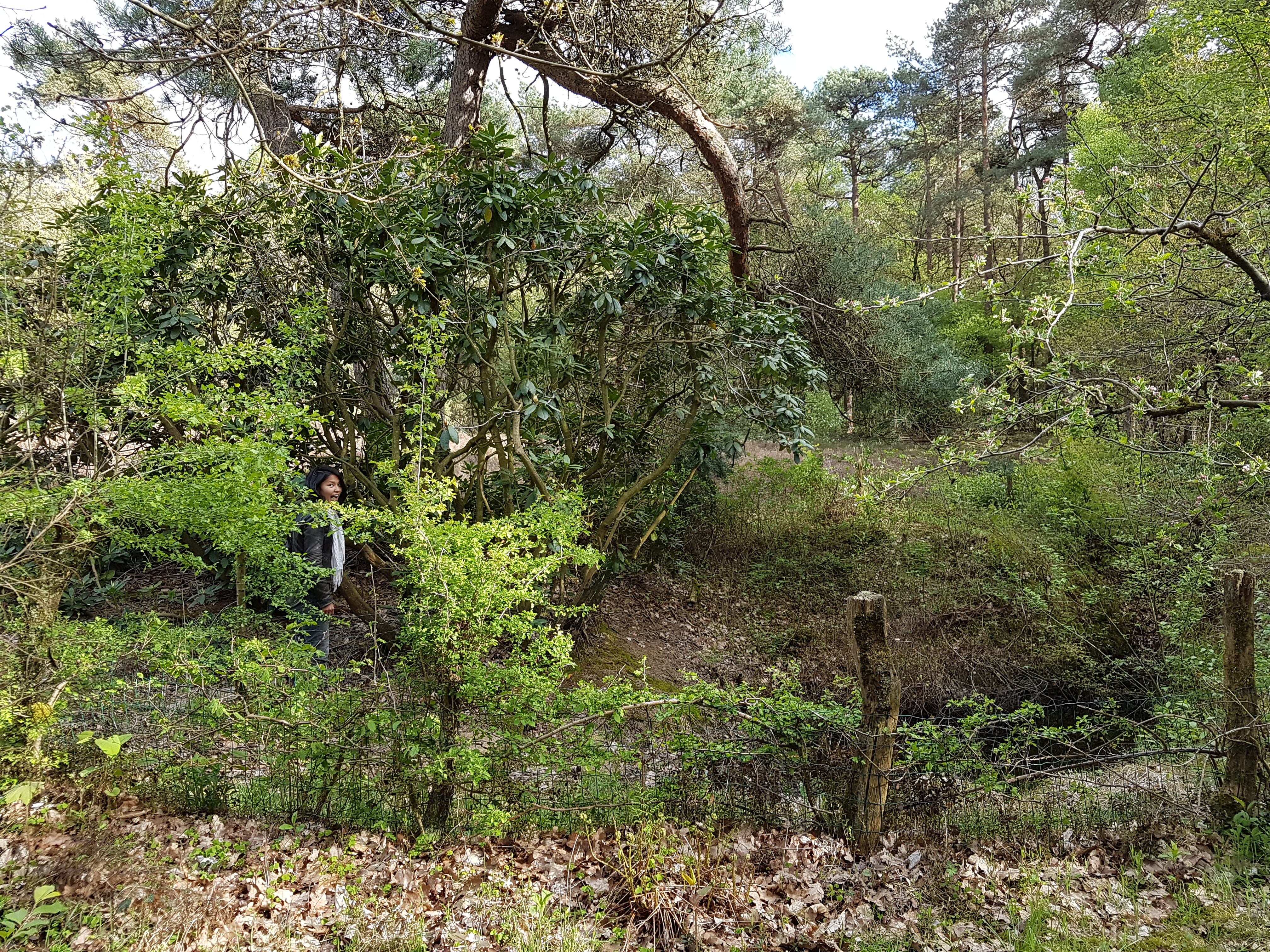
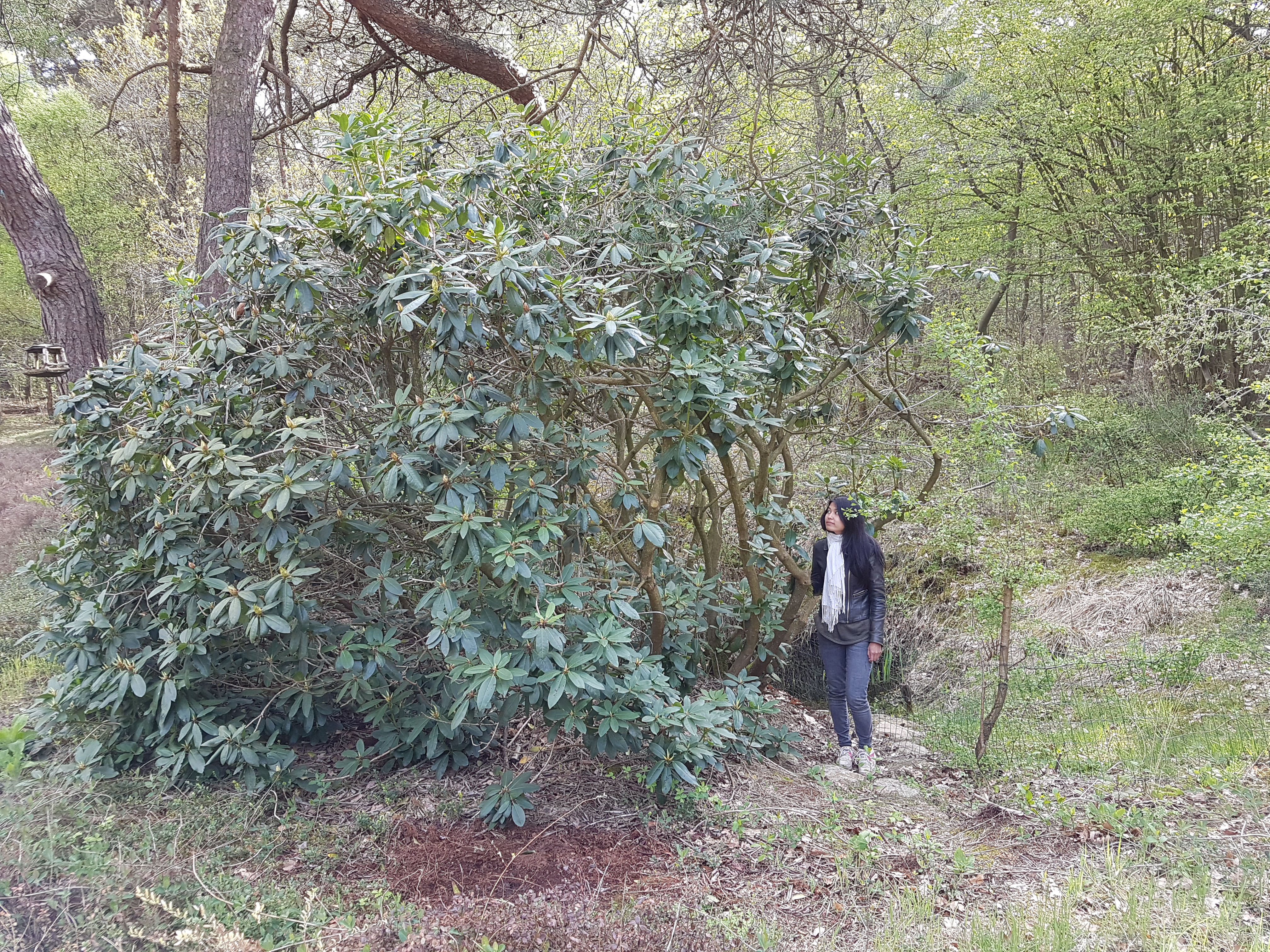
Marilisa, too, has taken to the greenery around De Schuilplaats. We’ve stayed there once or twice per year since our courtship became serious in 2015. During those stays, initially, Marilisa—a suitably elf-like helper in such a fairyesque environment—preferred to get her projects assigned by me. While her confidence and skill grew, her creative influence began to make its own mark on the garden. Like my father, Marilisa has also always been fascinated with water and what lives inside it. The first thing she had showed me when I first visited her parents was their pond. Popko’s pond, then, quickly drew her attention, as soon as she discovered what lay hidden behind that large Rhododendron bush. So, in 2016, she took the initiative to reduce that Rhododendron by at least a quarter. (Uncle Hugo was a bit nervous about the severity with which we brought back that luscious purple presence right next to the south terrace, but, in the typical way of Rhododendrons, it took the bush only 2 years to regain its former fullness and relegate its temporary bareness to the past.) With the Rhododendron pushed back to humbler proportions, I started, in 2017, with the help of Popko, to clear the mulchy, rich muck from the pond.
Or so I thought. We started at the top, right next to where the Rhododendron now ended [behind Marilisa in the picture above]. What we did not expect to find was a stair, with steps made out of long-rotten board and field stone. It didn’t take long before Popko (already past hist 70th birthday at the time) started attacking peat and Rhododendron root with more enthusiasm and vigor than myself, overtaken as he was by the mystery of what nature had done to his memories. “The steps couldn’t be there.” “I’m sure they were much farther away from the Rhododendron”. We unpealed bucket after bucket of peat made of Rhododendron leaf, pine needle, pine cone, branch, strung together by root. And, yes, the original stairs that Popko made long, long ago went straight through where thick, tall Rhododendron stems stood only a year earlier. Yet, at the same time, everything he built was still there, a little displaced here and there, but mostly intact. Nature had prevailed for a long time, overgrowing the memory of one of the most creative parts of Popko’s old project. And then, part of the veil was lifted, like the removal of a plaster mold, to reveal something that had matured in hiding, in a cocoon.
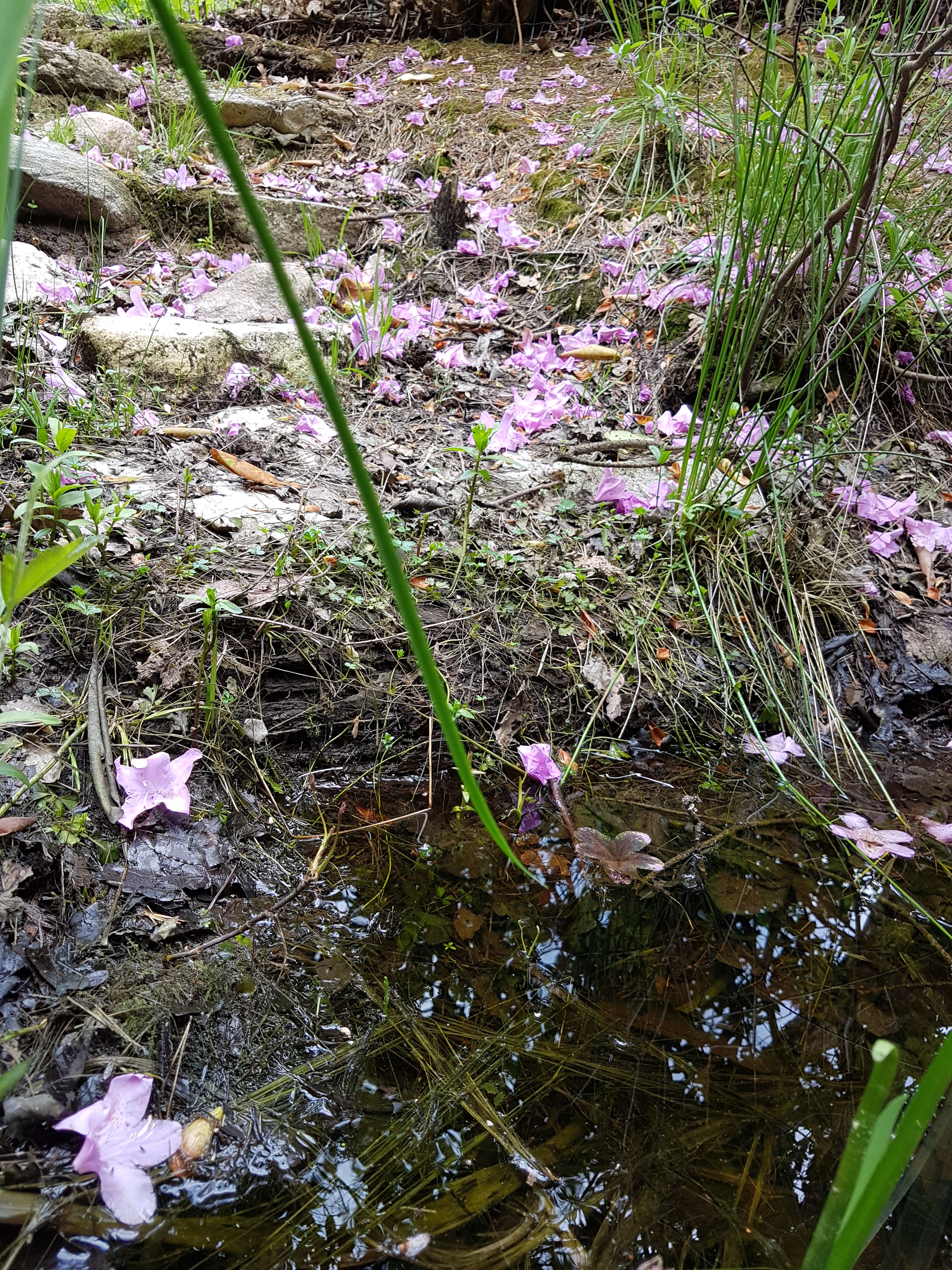
That was when Popko visited Marilisa and me while we were staying in De Schuilplaats in late 2017. I remember how he and I—especially he!—were slaving away at the rooty peat layer while Marilisa and a friend of Marilisa were sipping tea in the sun on the south terrace. (I’m not sure that they would have enjoyed the show that long if I had kept my shirt on.)
One year later, in November of 2018, the two of us (♂ and ♀) spent a sunny week at De Schuilplaats again. None of the luscious wetness that had still filled the pond in the late spring had persisted throughout the extraordinarily long, dry summer. Conveniently, this would allow us to get to the bottom without getting wet. Following the pattern of the previous year, I tentatively took to the pond, aiming only to muck it out to counter the ongoing eutrophication and deepen the base. That was until Marilisa’s creative input took the upper hand, and my original, purely ecological, aim became a vague background notion to a more magical mission.
Congruent with my original intent, we started by removing a fair bit of muck before we got to the more creative part. The muck had to be removed by the bucketload, because the protective fence doesn’t allow wheelbarrows to cross. So, we mucked. And we mucked a bit more.
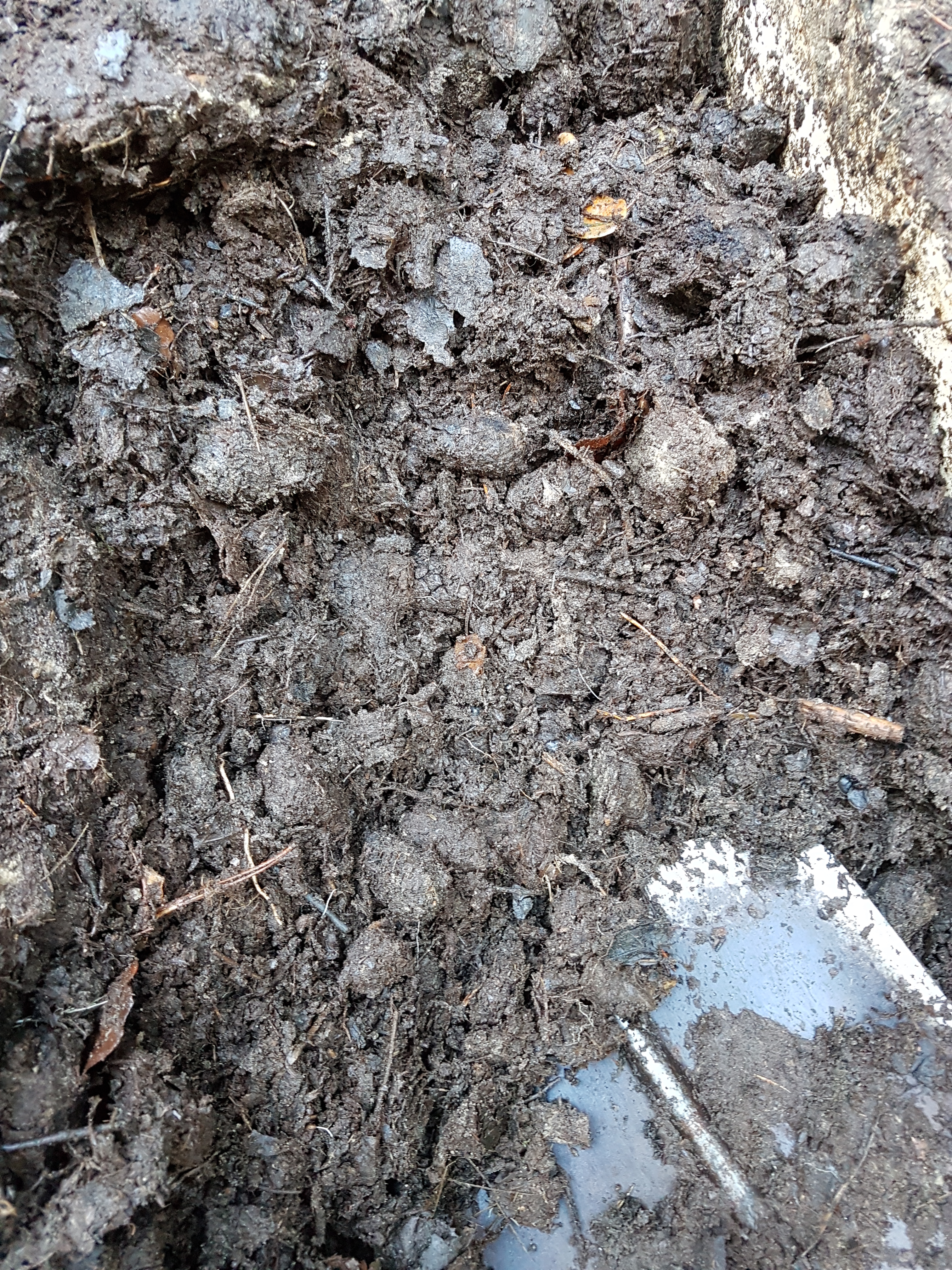
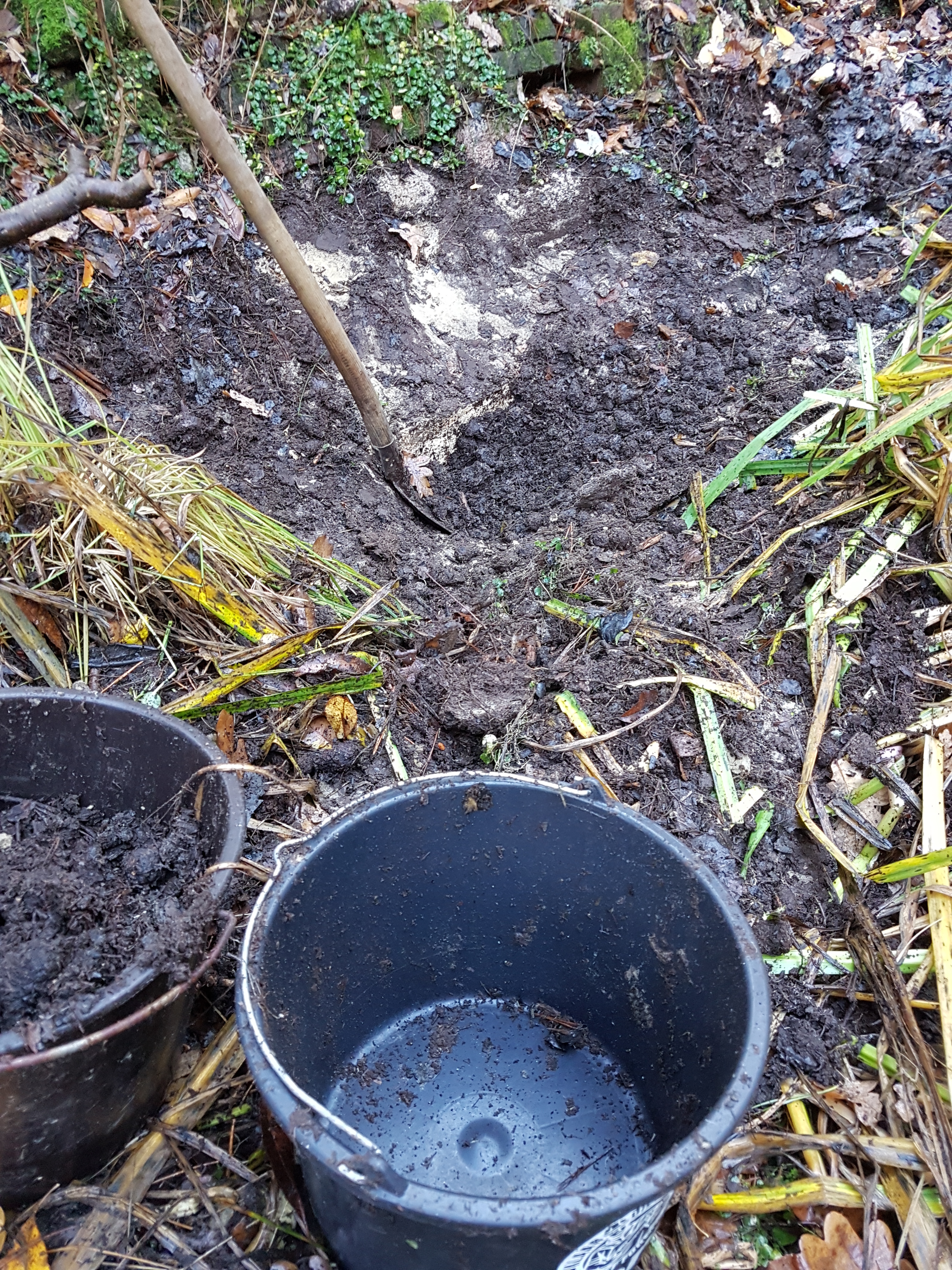
We weren’t going to discard the peaty mud mixture. That would be a waste of such a dense nutrient mass in the sandy, acidic, oligotrophic Norger environment. Rather we applied most of it to Marilisa’s new semi-wild Vaccinium myrtillus tract and to her artichoke patch. The remainder we left in a loose pile next to the vegetable, to let fresh oxygen touch the blackened leafs and pine cones. [While writing this, I figured that their next stop is to be mixed into my coffee grounds + leaf + branch compost heap.] To be used as fertilizer is quite a suprising turn of fate for plant parts that had spent decades in their submerged kingdom, waiting patiently to be turned first into turf and then into coal.
For us, this was no surprise, except for the amount of undigested material. Yet, the deepening of what I then still considered Popko’s pond brought surprises for us as well—there were 4 major ones.
Surprise #0: There’s a stair.
Oh, I discussed that one already.
Surprise #1: The pond’s base is reinforced.
I never knew better than that the pond would often dry up completely in the summer, even in the winter sometimes. I did have some hope that clearing out the base would lower the water table threshold at which there would be water left in the pool. But, because the pond isn’t lined with plastic, its water level would always change with the ground water level.
Popko knew better. He knew he left a little surprise at the very bottom. It was 40 cm deep and a meter by a meter wide. It was more than completely filled with dry sludge. Popko had placed a metal tub at the base of the pond to retain some water even at the lowest ground-water levels.
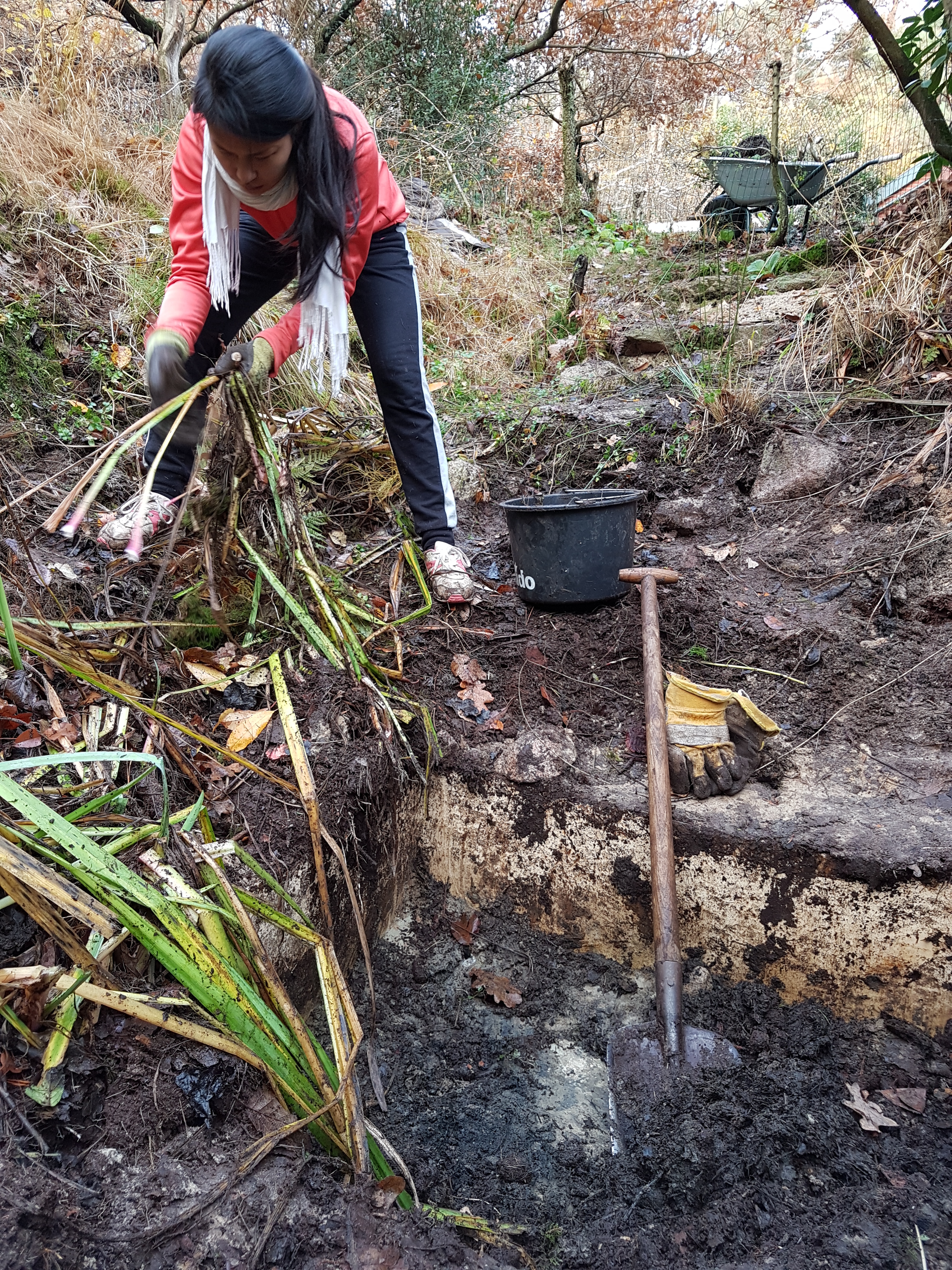
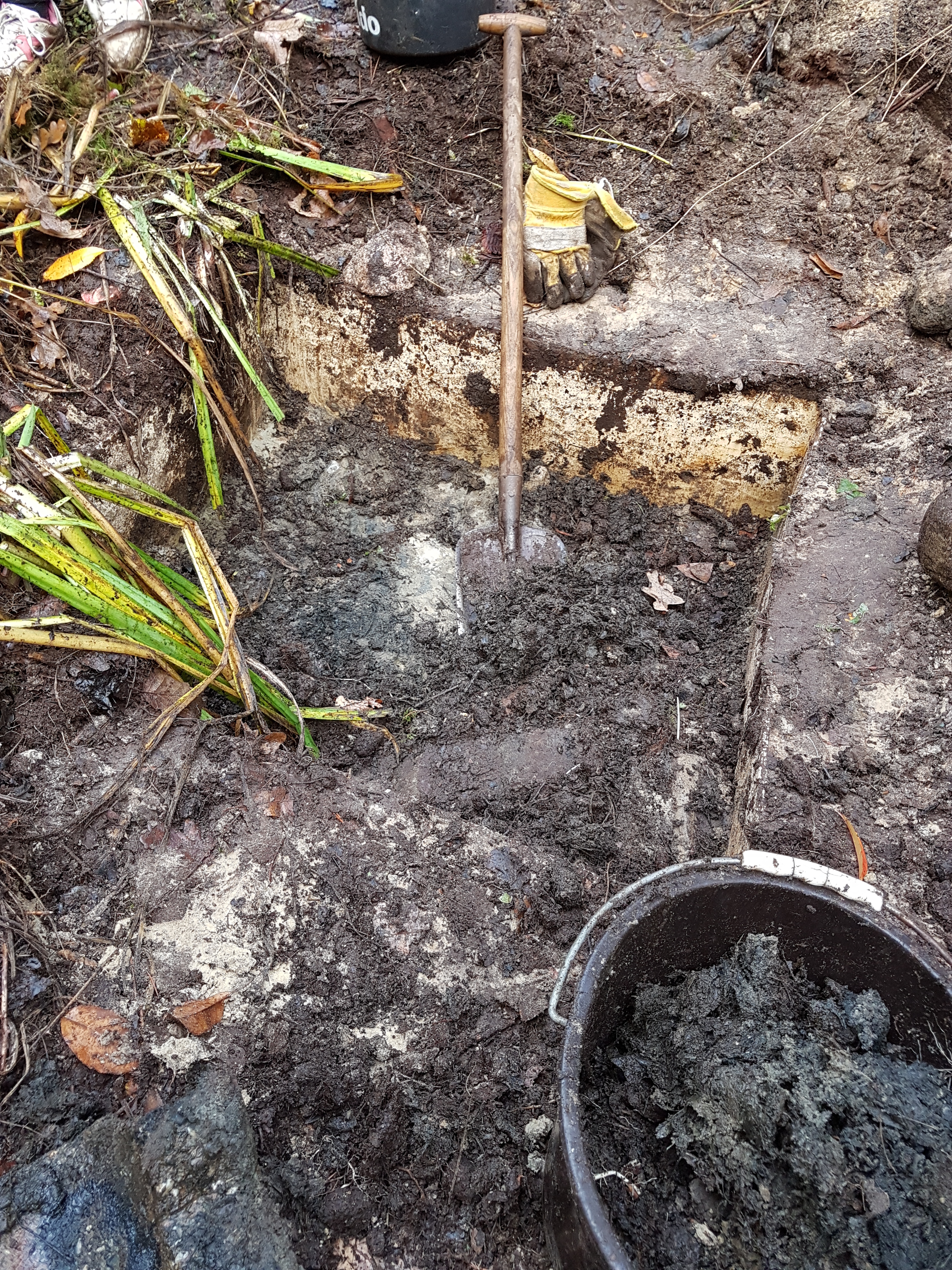
Surprise #2: A field stone slope was hiding under the moss and grass.
The heather-side slope had always just been a source of labor for me. Every year, I freed the sweet-scented Dutch myrtle (Myrica gale) from sprawling, crawling willow shoots and the always enthusiastic bramble branches. Below these bushes: grass and moss. As far as I knew, only the very steep red-brick wall at the opposide side of the pond was made out of something else than earth, not this more gently-sloped side.
When Marilisa started pulling away some of the moss, we found field stones. In Drenthe, the Dutch province where the Schuilplaats is location, there is no naturally occurring rocky substrate. Fieldstones in the Northern Netherlands were carried here from Scandinavia by land ice during the Saale glaciation that ended about 130,000 years ago. All our fieldstones are glacial erratics, brought here by glaciers. These particular fieldstones, however, were not carried there by ice; they were carried there by a Popko, about ten years younger at the time then I am now, and plenty strong.
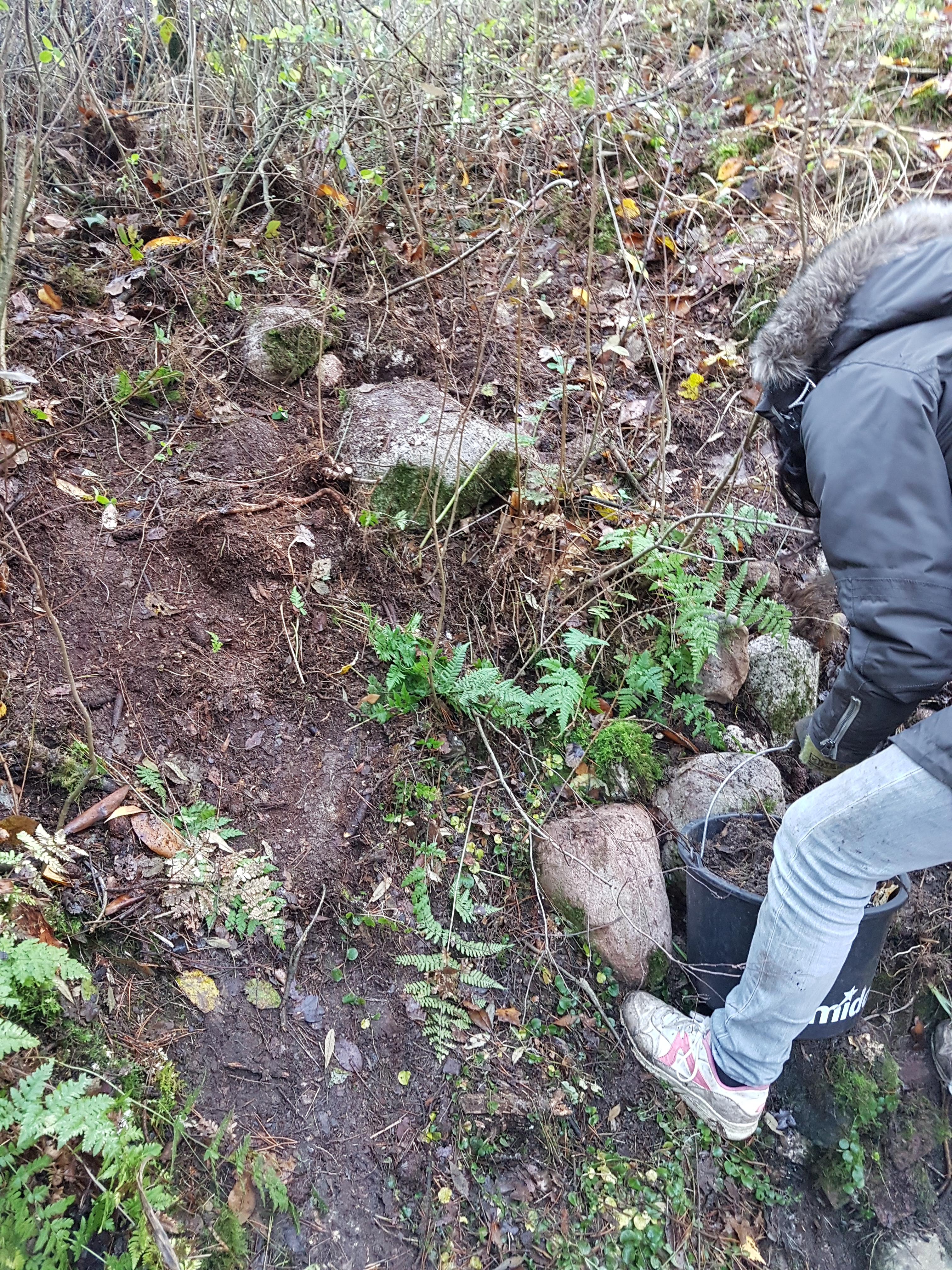
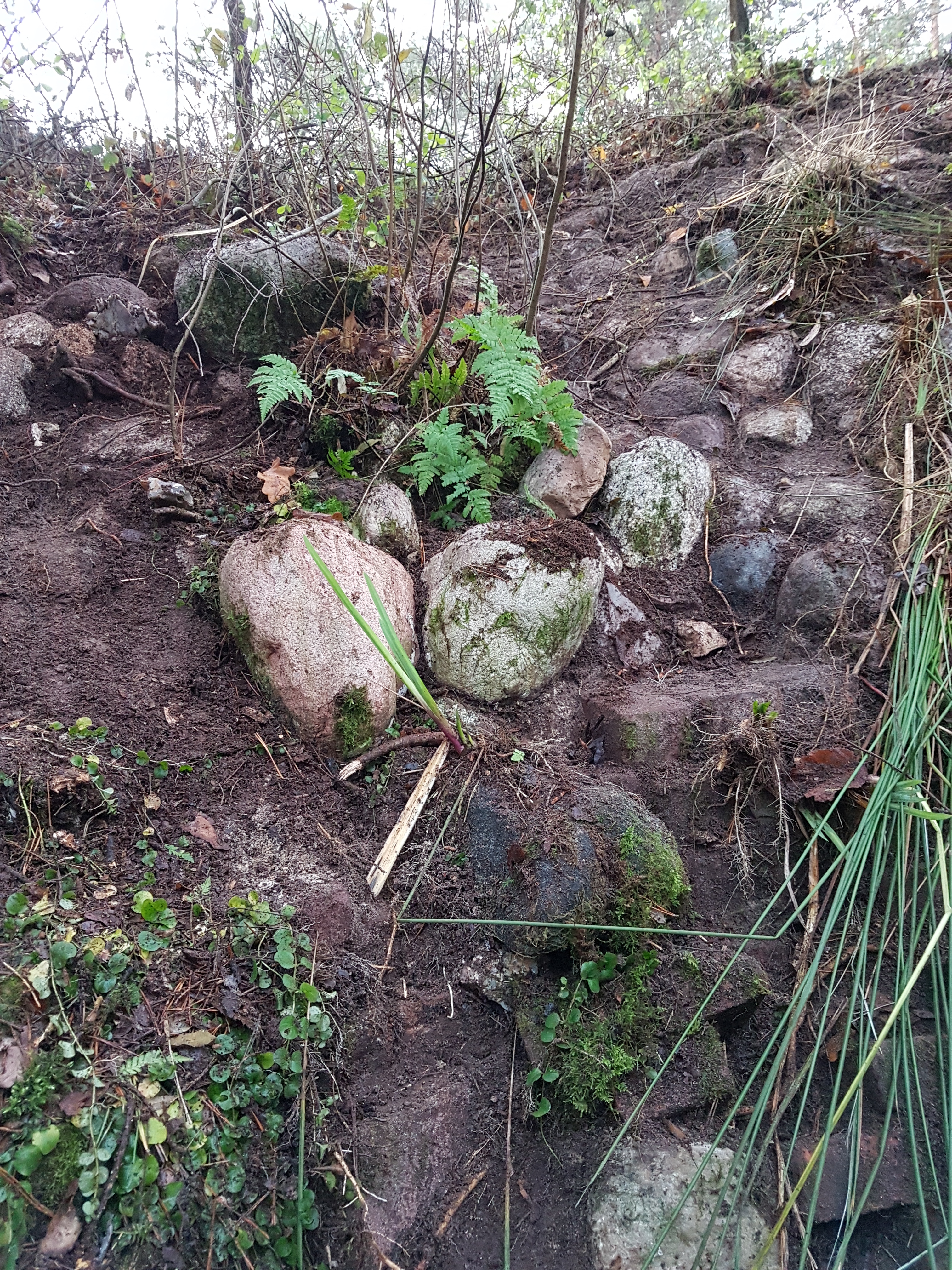
Surprise #3: The pond is big.
We had to remove wheelbarrow loads of greenery and dirt before this became noticable, but, for something Popko dug by hand, the pond is big.
When approaching it from the direction of the southern terrace, the North side of Popko’s pond opens with a stairs. As the fieldstone steps descend from the right (west) side of the large Rhododendron, the bassin quickly widens, with a steep brick facade against the west wall and a gentler fieldstone slope going up to the Rhododendron and the heather field behind it. At the south end, where the east side narrows, the field stone slope changes into a steep brick corner. Around the corner the bricks continue into a narrowing gulley where they meet the steep west wall in a shallow, pointy end at heather level.
In the gulley (which is not technically a gully), we didn’t remove the peaty substance. Instead, I made a small brick ridge in front of the Vaccinium corymbosum that I retrieved from my mother’s—I mean ♀ parent’s—garden before she moved much of the rest of her garden to Portugal a summer earlier. That delicious blueberry had been doing alright its first year in Norg. It didn’t mind being submerged much of the winter of 2017/2018. Nor did it seem to be bothered by the fact that I had had to clumsily and badly plant it under water. (Try it! Try to dig a hole under water, and then try to fill it with soily stuff.) Nevertheless, it didn’t yield any berries in its first two summers, which is why, instead of deepening its standing place, I applied copious amounts of extra thick, dark, partially-degraded stuffs from the rest of the pond, and the red brick ridge was meant to keep all that biomass firmly in place. (I knew that V. corymbosum loves that stuff; by planting them in wet turf, Popko has spoiled 2 other V. corymbosum specimen into a multi-kilogram annual blueberry yield in his garden in Eelde.)
Surprise #4: Is that still drinkable?
Burried below decades worth of tree trash was a bottle. It was less than half-full, with what I assumed to be pond water. When I opened the lid, I was in for a surprise: it reeked of liquor, the sweet kind—probably too sweet for me.
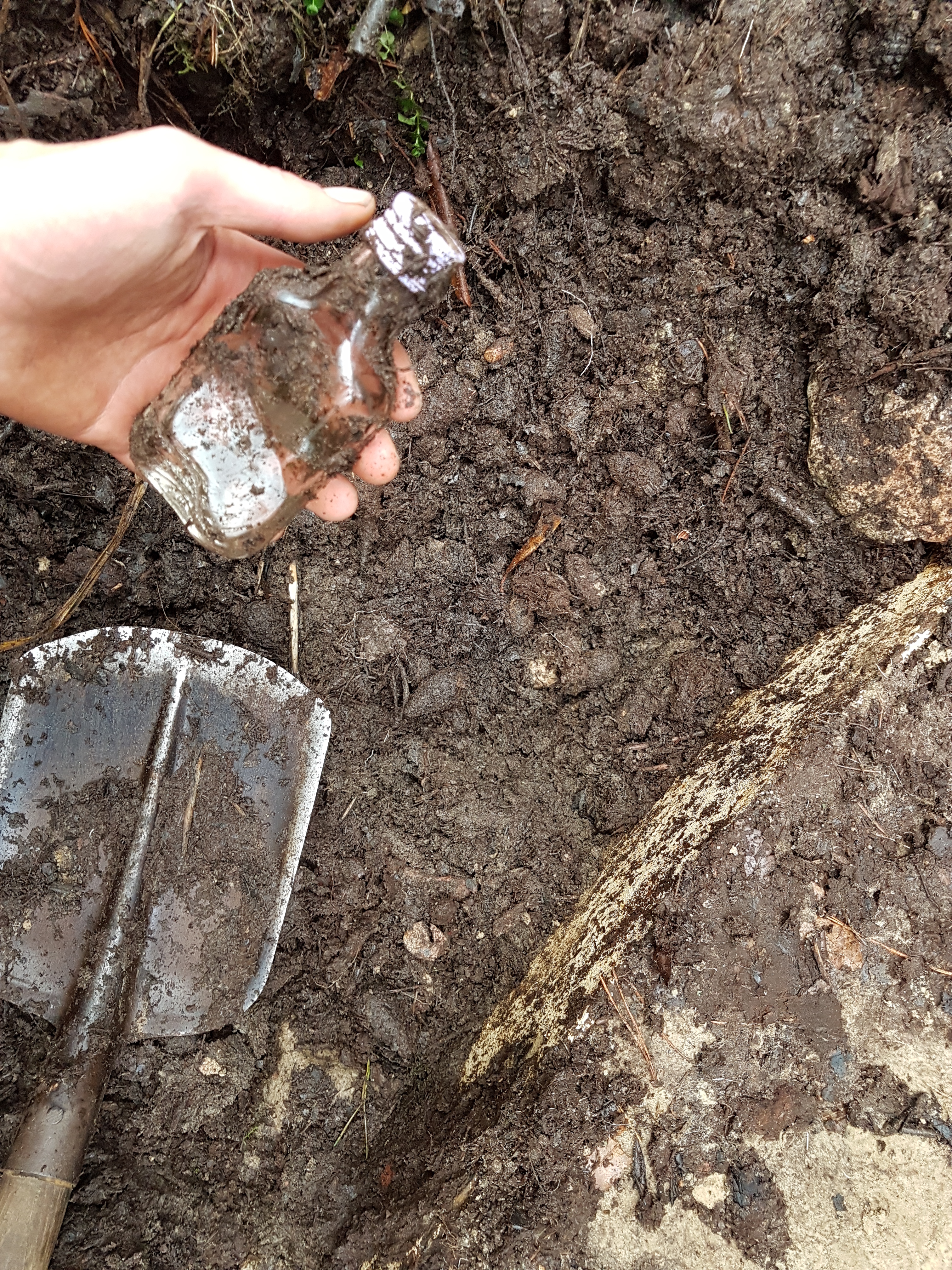
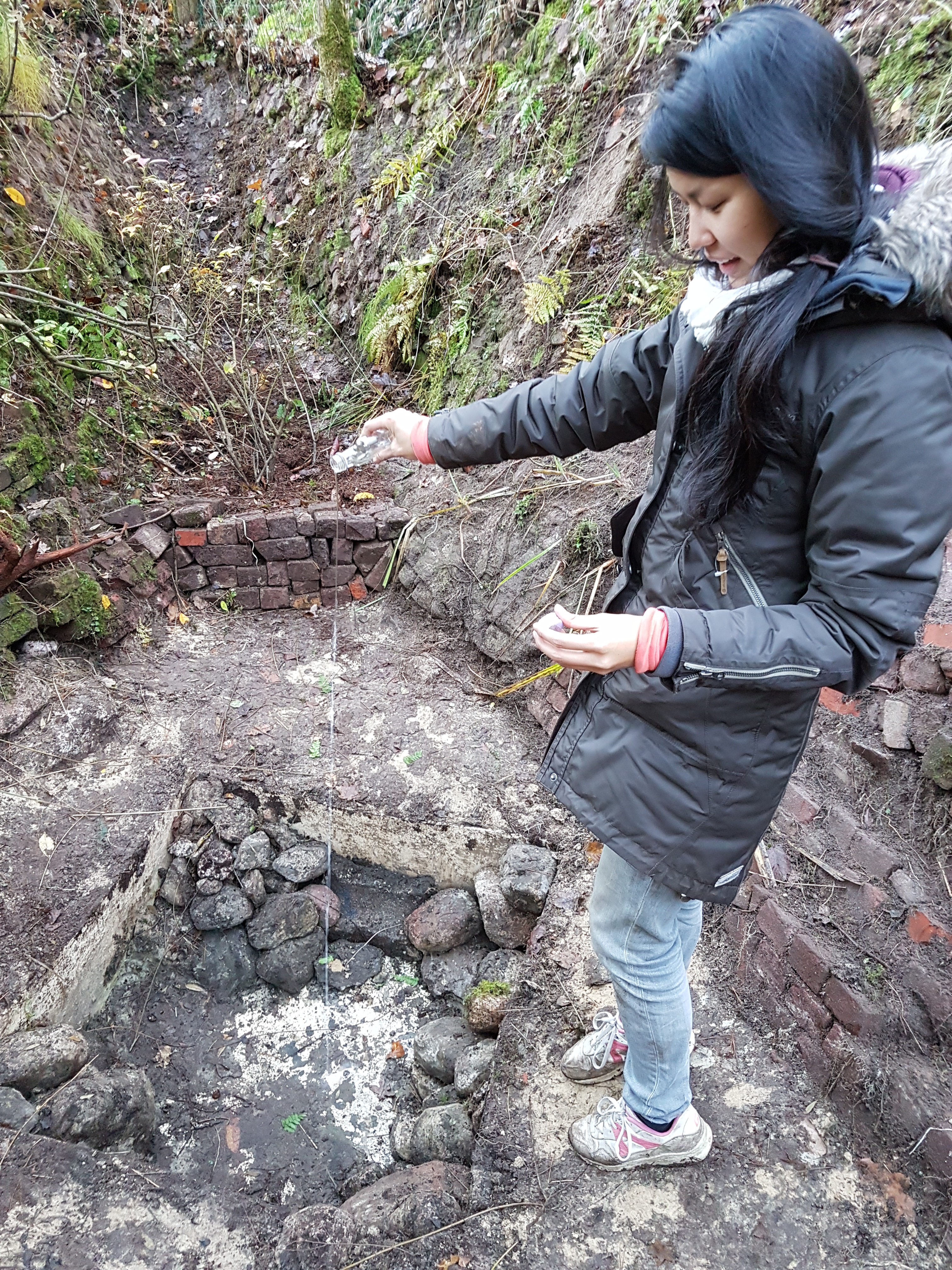
After cleaning the bottle a bit, I tried a few sips. Marilisa tried a drop. Like I expected, the stuff was way too sweet for me, but it was still good, as long as by ‘good’ you don’t mean delicious.
I suspect my father, who is fond of sweet drinks. Given the amount of muck it was burried under, it might as well have been my father’s father, who, however, would have been more inclined towards something more jenever-like.
We found a better use for the drink. We sacrificed it to the forest spirits. After we finished our work, Marilisa blessed Popko’s Pond 2.0 with a suitably sweet drink for the sweettooth that is Popko.
Future surprises
Popko’s pond is no longer purely Popko’s. For years, I was already removing willow, bramble, Japanese knotweed, and oak. The fence project involved yet another input, from Edwin Kielman. But, mostly it was Popko who put something in there these 40 years ago, letting the future twirl through it quite naturally (sometimes in the form of me mindlessly removing the woody plants that are not bog myrtle). Then, Marilisa, with my help, took what time had built and sculpted at it, stopping in time to leave plenty of the work of nature intact. Now, it’s up to nature to continue its work on this new base. Meanwhile, I’ll be removing willow, bramble, Japanese knotweed, and oak.
